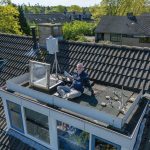The observation of this years Perseid maximum had to be delayed half an hour due to clouds. That left only 2,5 hours suitable for meteor observations before morning twilight. The moon was higher in the sky than the night before, making the sky even brighter. I still wanted to give this years Perseid maximum a chance, and started to make observations under a bright but cloudless sky at 22:30 UT. The count for this night is given in 30-minute periods.
The first half hour period gave Perseid rates of 5, close to the activity level from the night before. A brilliant -2 mag Perseid with a smoke train close to the radiant in Cassiopeia, was the highlite of the period.
In the next 30-minute period, activity level rose to 9 meteors, a clear step up in activity from the previous night. The brightest Perseid seen in this period was of magnitude +0.
In the third period activity was quite constant with 8 meteors seen. Most of the Perseids seen in this period were between mag -1 and +2. At 00:03 UT a brilliant, slow moving sporadic meteor with a final flare of mag -3 glided through Ursa Major. This meteor may have been an Alpha Capricornid, but it was impossible to determine the radiant precisely because of the lack of visible stars in the brightly moonlit southern horizon.
The fourth period gave the best counts of the night, with 11 Perseids seen. Most of the meteors were between mag +0 and +3, with no really bright events.
The last 30-minute period the sky was becoming even brighter with a Lm of 5.12. 7 Perseids were seen in this period, with the brightest meteor being a -1 mag in Cassiopeia.
It is difficult to rate this Perseid maximum due to the bright observing conditions. Anyway, I have the impression of a modest activity level, with an almost total lack of meteors brighter than -1. Despite the bright moonlight, I got an impression of the strength of the maximum and gathered some memorable moments worth the sacrifice of a night sleep.
A total of 49 meteors were seen in 2,5 hours of observation. Of these were: 40 PER, 9 SPO, and 0 KCG.
Observed showers:
Perseids (007 PER)
Kappa Cygnids (012 KCG)
22:30 – 23:00. Teff: 0.500, F: 1.00, Lm: 5.26, RA: 330, DEC: +75
PER: 5 meteors. -2, +0, +1, +4(2)
SPO: 2 meteors. +5(2)
KCG: 0 meteors.
23:00 – 23:30. Teff: 0.500, F: 1.00, Lm: 5.26, RA: 330, DEC: +75
PER: 9 meteors. +0, +1(2), +2, +3(3), +4(2)
SPO: 1 meteor. +2
KCG: 0 meteors.
23:30 – 00:05. Teff: 0.500 (5 minutes break), F: 1.00, Lm: 5.26, RA: 330, DEC: +75
PER: 8 meteors. -1, +0(2), +1(3), +2, +5
SPO: 4 meteors. -3, +1, +3(2)
KCG: 0 meteors.
00:05 – 00:35. Teff: 0.500, F: 1.00, Lm: 5.17, RA: 330, DEC: +75
PER: 11 meteors. +0, +1(4), +2(2), +3(2), +4, +5
SPO: 2 meteors. +0, +5
KCG: 0 meteors.
00:35 – 01:05. Teff: 0.500, F: 1.00, Lm: 5.12, RA: 330, DEC: +75
PER: 7 meteors. -1, +0(2), +1(2), +3(2)
SPO: 0 meteors
KCG: 0 meteors.





